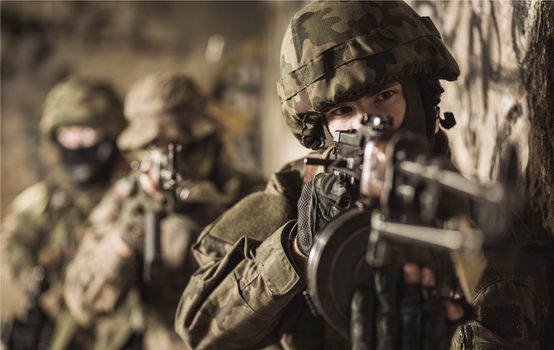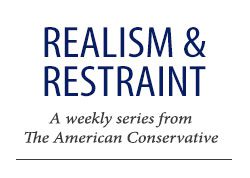Why Are Women in Combat?

Drowned out by the cacophony of the incoming administration was the fact that America’s first female recruits began infantry training at Ft. Benning, Ga., this month. More than a year after the Pentagon lifted the ban on women serving in combat roles, the first class of coed 11X (infantry with options to attend advanced schools such as Ranger and Special Forces) recruits is set to graduate in May. “More than 500 women are slated to join combat MOSs this year, according to U.S. Army Recruiting Command statistics,” reports The Army Times.
 To someone like me who attended infantry training at Ft. Benning over a decade ago, these far-reaching changes have the unreal quality of a dream. Back in 2005, as the insurgency in Iraq was heating up and “The Home of the Infantry” was monomaniacally focused on urban warfare and spotting IEDs, a prediction that women would eventually join the infantry would have belonged to the crackpot or crank. The general consensus in the barracks seemed to be that it would be foolish to force such a drastic experiment on the military during a time of war. It was an attitude that rendered the question of whether women were physically or mentally fit for combat almost moot.
To someone like me who attended infantry training at Ft. Benning over a decade ago, these far-reaching changes have the unreal quality of a dream. Back in 2005, as the insurgency in Iraq was heating up and “The Home of the Infantry” was monomaniacally focused on urban warfare and spotting IEDs, a prediction that women would eventually join the infantry would have belonged to the crackpot or crank. The general consensus in the barracks seemed to be that it would be foolish to force such a drastic experiment on the military during a time of war. It was an attitude that rendered the question of whether women were physically or mentally fit for combat almost moot.
But what did matter then, and what continues to grow in relevance as our wars in the Middle East drag on indefinitely, is the stark disconnect between the American military and the American public. In 2005, the problem didn’t seem to be diversity within the Army itself, but the fact that the military was like a universe parallel to and almost completely misunderstood (when it wasn’t being ignored) by the civilian world. Questions like whether transgender people should openly serve or whether women should be in combat almost seemed like a distraction from the larger issue—the military being cordoned off from the country itself. Simply put, making the military more inclusive as an institution doesn’t bind it more intimately with average citizens or make it more responsive to our republic. It just renders the bubble that surrounds it in technicolor.
♦♦♦
Profound divisions in American society are never so obvious as during election years. And in a counterintuitive twist, our tribalism can actually seem like a fundamental facet of our collective national character. We hunker deeper down into our political and cultural identities, demarcating ourselves from one another with “in” and “out” group codifications. Sometimes the categorizing is a moral necessity. Sometimes it’s glib theatrics. But the chasm that separates the military from the everyday experiences of civilians is morbid. And it continues to grow.
The civilian/military divide is partially explained by a drop in sheer numbers of veterans. According to a study by the Pew Research Center:
The share of the population with military experience—counting those who are on active duty or were in the past—has fallen by more than half since 1980. Then, 18% of adults were serving or had served in the military. By 2014, the share had declined to 8%, according to Census Bureau data, with an additional 1% serving in the reserves. Among U.S. men, the decline was even more dramatic, dropping from 45% in 1960 to 37% in 1980 and 16% in 2014.
According to VA projections, that trend will continue into 2045, when they predict that the total number of veterans will dip to around 14.5 million as Vietnam and Gulf War veterans pass away. What this means is that, as we move further and further away from the elimination of the draft, fewer and fewer Americans are fighting in our wars. From a high of around 9 percent of the population serving on active duty during World War II to a low of 0.05 percent for post-9/11 deployments, fewer Americans are sacrificing for their country. And Washington suffers too: the number of veterans in Congress has plummeted from a high of 75 percent in the late ’70s to just around 20 percent now.
To some, fewer veterans might seem like a good thing, as if it indicated less global military engagement. Obviously it doesn’t. And while it is true that the Pentagon’s Third Offset Strategy (and every previous Offset Strategy) carries the animating logic of replacing humans with technology, not everyone will have the luxury of experiencing combat from inside an air-conditioned office. And so the burden of fighting what has become the longest war in American history falls on the shoulders of a shrinking cohort of outsiders who are forced to endure deployment after deployment, further disconnecting them from the country they’re fighting for. Anyone who has read the masterly Ben Fountain novel Billy Lynn’s Long Halftime Walk, a satirical novel about the experience of Iraq War veterans participating in a so-called victory tour, will understand how this disconnect can feel like a betrayal to veterans. It’s something I’ve felt myself.
As terrible as that alienation might be, you won’t hear veterans complain too loudly about enduring it. It might not be what they signed up for, and it certainly isn’t what they deserve, but it’s something everyone has adjusted to over the past 15 years or so. That same alienation seen from the other end—civilians cut off from the violence conducted in their name—is, however, much more dangerous. To put it plainly, if average Americans were forced to deploy to the roughly 150 countries worldwide in which we currently have a military presence, I predict that you would see a profound shift in our defense posture and foreign policy. That the sacrifices are borne by such a tiny elite is one of the mechanisms that makes our reckless military overreach possible in the first place.
Smarter minds than mine agree. Immanuel Kant argued in his pamphlet Perpetual Peace that democratic participation in the military is a prerequisite for peace. Many Enlightenment thinkers went in the opposite direction, asserting that peace laid the groundwork for a participatory government (in all senses, including military service). Kant disagreed, arguing that the very foundations of peace were “citizens, whose periodic and voluntary military efforts will win security from aggression for themselves and their country.” He goes on to compare the military decisions of the sovereign—in this case, anyone in the role of consenting to war—to forming a hunting party. It becomes a diversion done on a whim, “without any significant reason, as a kind of amusement.” Reducing the strain of war upon the population while continuing to wage it, insulating them from the failures of policy and strategy alike, gives America’s Long Wars the ambiance of a hunting party waged by out-of-touch royals.
♦♦♦
But what does this disconnect have to do with women in combat? Nothing—and that’s exactly the point. Opening combat roles to women lends a veneer of democratic engagement without actually having any real connection to larger society. The military remains a menagerie, just a slightly more interesting one. And as former Secretary of Defense Ashton Carter himself admitted, what this demographic shift, among others like trans-inclusion, really portend is a human-resources grab:
The Defense Department and the military need to avail ourselves of all talent possible in order to remain what we are now—the finest fighting force the world has ever known. … We don’t want barriers unrelated to a person’s qualification to serve preventing us from recruiting or retaining the soldier, sailor, airman or marine who can best accomplish the mission. We have to have access to 100% of America’s population.
So really, this is about the Pentagon’s “right” to hire whomever it wants in order to engage in an endless national hunting party. It isn’t about some renaissance in military/civilian relations or a restoration of the military’s bond with the public. The deployments continue. The only difference is that now women will get to wear a Combat Infantryman’s Badge when they pull the trigger, usually in countries where Americans shouldn’t be in the first place. And that’s hardly a victory for anyone.
Scott Beauchamp is a veteran and writer based in Portland, Maine.
Comments